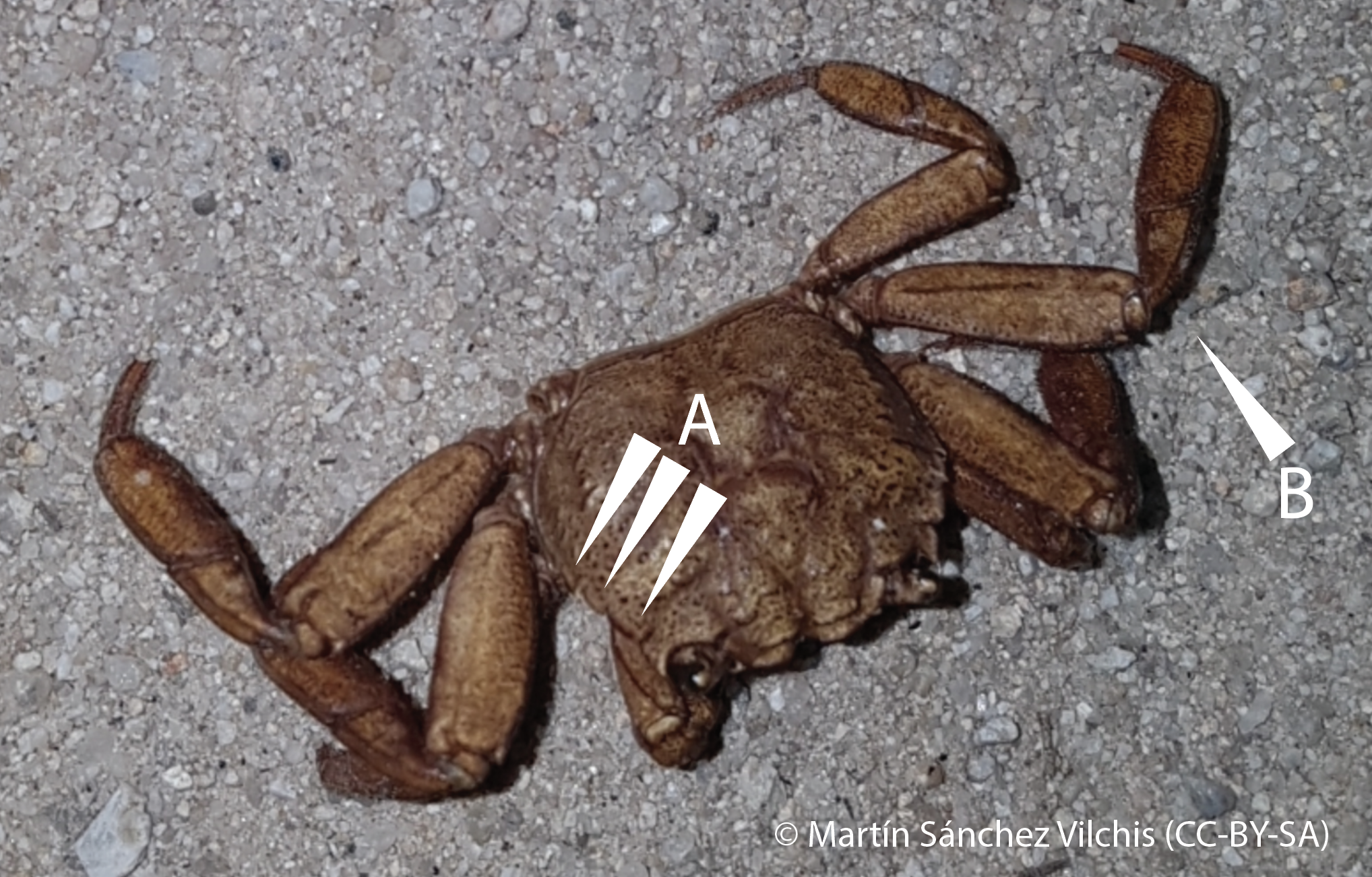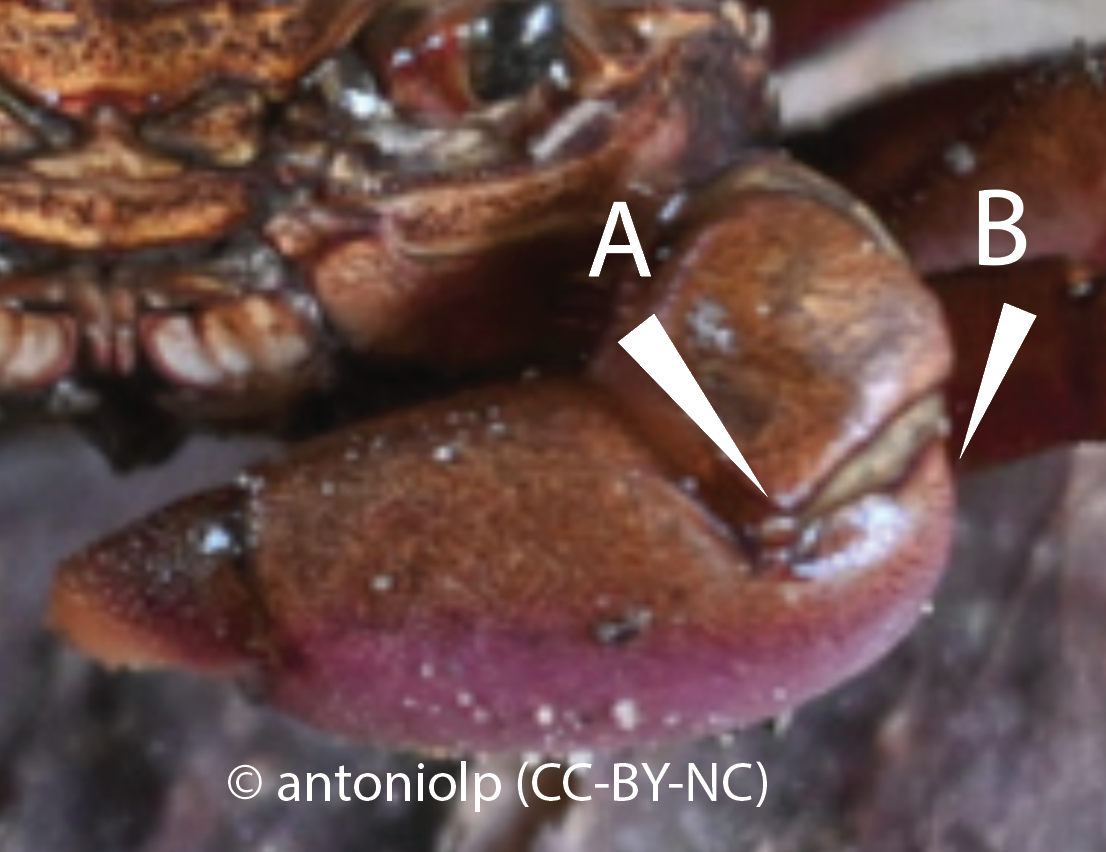17 observations of an iNat first - Glyptograpsus impressus
After nerding out this evening, I’ve found 17 observations from the Eastern Pacific that are Glyptograpsus impressus. This species was previously unrepresented on iNat and surprisingly I could find no recent (color) or living pictures of this species on the internet.
Before tonight these unidentified grapsid (sensu lato) crabs on iNat from the Eastern Pacific clustered around Mexico that have been really bothering me. They have toothed Anterolateral margins so I’ve mistaken a few of them for Sesarma. But today I realized that the males have one claw that is larger than the other. And I came upon this paper by Cuesta and Schubart “The first zoeal stage of Glyptograpsus impressus, with comments on the subfamilial arrangement” that mentioned a grapsid genus I wasn’t familiar (Glyptograpsus) as having: “In adult morphology, the pronounced chelar dimorphism of Glyptograpsus is another character which is unique among the grapsid crabs (with the exception of Playtchirograpsus...)” In other words, Glyptograpsus and Playtchirograpsus uniquely are grapsids where males where one claw is bigger than the other
Turns out these two genera make up a family Glyptograpsidae with 3 species:
Glyptograpsus impressus - distributed from Acapulco, Mexico, to Colombia along the Pacific
Glyptograpsus jamaicensis - endemic to Jamaica
Platychirograpsus spectabilis - endemic to Gulf of Mexico (Tabasco–Veracruz, probably introduced into Florida)
Live pictures of these crabs are very scarce on the internet. Here’s a picture of Glyptograpsus impressus, here’s one of Glyptograpsus jamaicensis and we have one observation of Platychirograpsus spectabilis. These crabs are similar and closely related, the most obvious difference being that Platychirograpsus spectabilis males not only have one larger claw but it has an extremely odd, exaggerated shield shape (in contrast the larger claw in Glyptograpsus is normal shaped)

Here’s my ID reasoning based on the description of the family in Glyptograpsidae, a New Brachyuran Family from Central America: Larval and Adult Morphology, and a Molecular Phylogeny of the Grapsoidea:
1 “Cephalothorax subgloboid, greatest width at base of third pereiopods” in other worlds, the carapace is rounded (almost like Grapsus, and unlike the squarer Arasmes and Sesarma) and widest (B) at the 3rd leg (A)

2 “Front undulated and relatively narrow, with deep median groove, two conspicuous frontal lobes, and two smaller posterior lobes.” I’ve pointed out the frontal lobes (A) and the posterior lobes (B) below. And
“Ischium and merus of third maxillipeds very broad (merus wider than long), ischium with two and merus with three longitudinal sulci (Fig. 1)” Note the wide merus with the longitudinal grooves (C).

3 “Anterolateral margin with three pairs of teeth (not counting exorbital angle), fourth pair often present as prominent tubercles.” Note A below. And “Third pair of walking legs longest.” Note B below.

4 “Chelipeds of adult males markedly heterochelous, in females homochelous.” and “Chelae spoon-tipped and, except major male claw, small; fingers short.” ie the claws are the same size and small in females (A) - note carying eggs - and one is bigger than the other in males (B)

5 “Articulation of carpus and palm of male major cheliped distal to proximal end of palm” Note they attach at A which is further (more distal) than the closest (proximal) end of the claw (B). Platychirograpsus’s crazy shield claw is kind of a super exaggerated version of this.

These characters are more or less consistent with those used in The grapsoid crabs of America by Mary J. Rathbun.
These crabs are being described as being like Mitten crabs (Eriocheir) in that "Glyptograpsus spends its adult life in inland freshwater but its adults must migrate downstream to release their larvae into the sea" (from A Global Overview of the Conservation of Freshwater Decapod Crustaceans) and “‘adults limnic’ is composed of those crabs that spend most of their lives in or near freshwater but migrate back to the sea or shed the larvae into the river current, so that larval development takes place in the ocean. This lifestyle is typical of the genera Eriocheir, Glyptograpsus, and Platychirograpsus, some species of Armases, and other IndoPacific sesarmid and varunid genera (discussed in Diesel and Schuh, 1998).” (from Molecular Phylogeny, Taxonomy, and Evolution of Nonmarine Lineages within the American Grapsoid Crabs (Crustacea: Brachyura)). The migration of gravid females downstream to the sea is certainly consistent with these three observations:
https://www.inaturalist.org/observations/85169260
https://www.inaturalist.org/observations/3131102
https://www.inaturalist.org/observations/85290382
Which show large aggregations of gravid females heading to the sea (though I have to admit if they are like Mitten Crabs I would have thought that their migrations would occur under freshwater and not on land as shown in these pictures...).
The size of these crabs as described in Ecological Aspects of the Freshwater Decapod Crustaceans of the Perlas Archipelago, Panama as “3-22m carapace length (male) 8-18mm (females)” is also consistent with 2 of those observations with pictures of the crab in hand for comparison.

Lastly, I went through the Grapsidae (sensu lat) in Checklist of brachyuran crabs (Crustacea: Decapoda) from the eastern tropical Pacific by Michel E. Hendrickx to reassure myself that there wasn’t some other candidate for these crabs:
GRAPSIDAE MCLEAY, 1838
- Aratus pisoni (H. MLLNE EDWARDS, 1837)
- Armases angustum (SMITH, 1870)
- Armases magdalenense
- Cyclograpsus cinereus DANA, 1851
- Cyclograpsus escondidensis RATHBUN, 1933
- Euchirograpsus americanus A. MILNE EDWARDS,
- Geograpsus lividus (H. MLLNE EDWARDS, 1837)
- Glyptograpsus impressus SMITH, 1870
- Goetice americanus RATHBUN, 1923 = Pseudogaetice americanus
- Goniopsis cruentata (LATREILLE, 1802)
- Goniopsis pulchra LOCKINGTON, 1877
- Grapsus grapsus (LINNAEUS, 1758)
- Hemigrapsus nudus (DANA, 1851)
- Hemigrapsus oregonensis (DANA, 1851)
- Pachygrapsus crassipes RANDALL, 1839
- Pachygrapsus minutus A. MLLNE EDWARDS, 1873
- Pachygrapsus planifrons de MAN, 1888
- Pachygrapsus transversus (GLBBES, 1850)
- Percnon abbreviatum (DANA, 1851)
- Percnon gibbesi (H. MILNE EDWARDS, 1853)
- Plagusia depressa tuberculata LAMARCK, 1818
- Plagusia immaculata LAMARCK, 1818
- Plagusia speciosa DANA, 1851
- Planes cyaneus DANA, 1852
- Sesarma aequatoriale ORTMANN, 1894
- Sesarma occidentale SMITH, 1870
- Sesarma rhizophorae RATHBUN, 1906
- Sesarma rubinofforum ABELE, 1973
- Sesarma sulcatum SMITH, 1870
- Tetragrapsus jouyi (RATHBUN, 1893)
I had to familiarize myself with Tetragrapsus, Pseudogaetice, and Euchirograpsus (Galapagos only) but after doing so I feel confident that there are no other candidates in the Eastern Pacific other than Glyptograpsus impressus.
I’m pretty sure I’ve ID’d these crabs correctly, but just to double check, I’ve emailed Prof. Dr. Christoph Schubart and John Christy since “The first zoeal stage of Glyptograpsus impressus, with comments on the subfamilial arrangement” describes them collecting adult crabs in Panama so they likely are very familiar with these crabs in life. I’ll follow up here with an update if they get back to me.
Pretty exciting to finally be able to put a name to these crabs. And also kind of shocking that while I can’t find a single color/living photo of Glyptograpsus impressus on the internet, we seem to have 17 observations hidden in plain sight here on iNaturalist!
Also 3 of these 17 records are from Costa Rica and Ecuador where I don't think the crab is known at least from the literature mentioned here and GBIF.
FYI @mazancourt, @mikegigliotti, @ondrej-radosta, @crabspromenade


